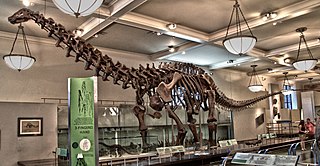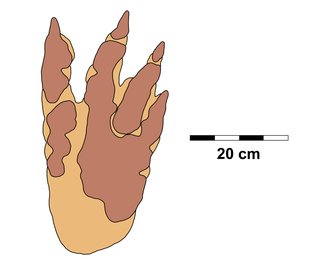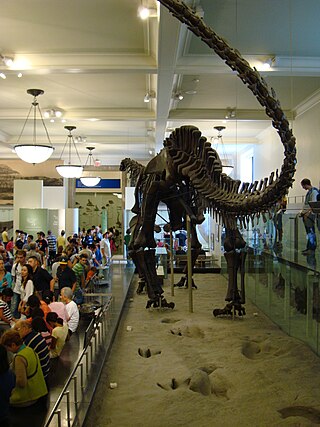
Apatosaurus is a genus of herbivorous sauropod dinosaur that lived in North America during the Late Jurassic period. Othniel Charles Marsh described and named the first-known species, A. ajax, in 1877, and a second species, A. louisae, was discovered and named by William H. Holland in 1916. Apatosaurus lived about 152 to 151 million years ago (mya), during the late Kimmeridgian to early Tithonian age, and are now known from fossils in the Morrison Formation of modern-day Colorado, Oklahoma, New Mexico, Wyoming, and Utah in the United States. Apatosaurus had an average length of 21–23 m (69–75 ft), and an average mass of 16.4–22.4 t. A few specimens indicate a maximum length of 11–30% greater than average and a mass of approximately 33 t.

Sauropoda, whose members are known as sauropods, is a clade of saurischian ('lizard-hipped') dinosaurs. Sauropods had very long necks, long tails, small heads, and four thick, pillar-like legs. They are notable for the enormous sizes attained by some species, and the group includes the largest animals to have ever lived on land. Well-known genera include Apatosaurus, Argentinosaurus, Alamosaurus, Brachiosaurus, Camarasaurus, Diplodocus, and Mamenchisaurus.

The Paluxy River, also known as Paluxy Creek, is a river in the U.S. state of Texas. It is a tributary of the Brazos River. It is formed by the convergence of the North Paluxy River and the South Paluxy River near Bluff Dale, Texas in Erath County and flows a distance of 29 miles (47 km) before joining the Brazos just to the east of Glen Rose, Texas in south central Somervell County.

Brontosaurus is a genus of herbivorous sauropod dinosaur that lived in present-day United States during the Late Jurassic period. It was described by American paleontologist Othniel Charles Marsh in 1879, the type species being dubbed B. excelsus, based on a partial skeleton lacking a skull found in Como Bluff, Wyoming. In subsequent years, two more species of Brontosaurus were named: B. parvus in 1902 and B. yahnahpin in 1994. Brontosaurus lived about 156 to 146 million years ago (mya) during the Kimmeridgian and Tithonian ages in the Morrison Formation of what is now Utah and Wyoming. For decades, the animal was thought to have been a taxonomic synonym of its close relative Apatosaurus, but a 2015 study by Emmanuel Tschopp and colleagues found it to be distinct. It has seen widespread representation in popular culture, being the archetypal "long-necked" dinosaur in general media.

Stegosauria is a group of herbivorous ornithischian dinosaurs that lived during the Jurassic and early Cretaceous periods. Stegosaurian fossils have been found mostly in the Northern Hemisphere, predominantly in what is now North America, Europe, Africa, South America and Asia. Their geographical origins are unclear; the earliest unequivocal stegosaurian, Bashanosaurus primitivus, was found in the Bathonian Shaximiao Formation of China.

Machimosaurus is an extinct genus of machimosaurid crocodyliform from the Late Jurassic and Early Cretaceous. The type species, Machimosaurus hugii, was found in Switzerland. Other fossils have been found in England, France, Germany, Portugal, Switzerland and Tunisia. Machimosaurus rex is the largest named teleosauroid and thalattosuchian, with an estimated length of up to 7.15 m (23.5 ft). Machimosaurus is the largest known crocodyliform of the Jurassic.

A fossil track or ichnite is a fossilized footprint. This is a type of trace fossil. A fossil trackway is a sequence of fossil tracks left by a single organism. Over the years, many ichnites have been found, around the world, giving important clues about the behaviour of the animals that made them. For instance, multiple ichnites of a single species, close together, suggest 'herd' or 'pack' behaviour of that species.

Europasaurus is a basal macronarian sauropod, a form of quadrupedal herbivorous dinosaur. It lived during the Late Jurassic of northern Germany, and has been identified as an example of insular dwarfism resulting from the isolation of a sauropod population on an island within the Lower Saxony basin.
Breviparopus is the name given to an ichnogenus of dinosaur, having been made by an unknown genus of sauropod. As an ichnogenus, the taxon is represented by a 90-metre (295 ft) long series of fossil tracks, or ichnites, found in the spring of 1979 in the Atlas Mountains of present-day Morocco. At the time, this area would have been part of the splitting Gondwana supercontinent. The animal that produced the Breviparopus tracks is rumored to be one of the largest dinosaurs, though its exact size has been the subject of much debate.

An animal track is an imprint left behind in soil, snow, or mud, or on some other ground surface, by an animal walking across it. Animal tracks are used by hunters in tracking their prey and by naturalists to identify animals living in a given area.

Eubrontes is the name of fossilised dinosaur footprints dating from the Late Triassic and Early Jurassic. They have been identified from France, Poland, Slovakia, Czech Republic, Italy, Spain, Sweden, Australia (Queensland), US, India, China and Brazil (South).

Otozoum is an extinct ichnogenus of sauropodomorph dinosaur from the Late Triassic-Middle Jurassic sandstones. Footprints were made by heavy, bipedal or, sometimes, quadrupedal animals with a short stride that walked on four toes directed forward. These footprints are relatively large, over 20 cm in pes length. Otozoum differs from Plateosaurus by having a notable homopody.

Apatosaurinae is a subfamily of diplodocid sauropods, an extinct group of large, quadrupedal dinosaurs, the other subfamily in Diplodocidae being Diplodocinae. Apatosaurines are distinguished by their more robust, stocky builds and shorter necks proportionally to the rest of their bodies. Several fairly complete specimens are known, giving a comprehensive view of apatosaurine anatomy.

The Purgatoire River track site, also called the Picketwire Canyonlands tracksite, is one of the largest dinosaur tracksites in North America. The site is located on public land of the Comanche National Grassland, along the Purgatoire ("Picketwire") River south of La Junta in Otero County, Colorado.

Carmelopodus is an ichnogenus of theropod dinosaur footprint. They are suggested to belong to basal ceratosaurs, due to their similarities with abelisaurid footprints. In 2016, a large footprint from the Early Jurassic of Morocco belonging to Carmelopodus sp. was estimated to belong to an 8 m (26 ft) long and 1.65 t heavy individual. Another footprint from the Middle Jurassic of the USA that belongs to Carmelopodus untermannorum, the type species, has a size of 4 cm (0.13 ft) and was made by an individual that was 68 cm (2.2 ft) in length and 1 kg (2.2 lbs).

Macropodosaurus is an ichnogenus of therizinosaurid footprints from the Late Cretaceous of Asia, North America and Poland. The ichnogenus is currently monotypic only including the type ichnospecies M. gravis, described and named in 1964.

The 20th century in ichnology refers to advances made between the years 1900 and 1999 in the scientific study of trace fossils, the preserved record of the behavior and physiological processes of ancient life forms, especially fossil footprints. Significant fossil trackway discoveries began almost immediately after the start of the 20th century with the 1900 discovery at Ipolytarnoc, Hungary of a wide variety of bird and mammal footprints left behind during the early Miocene. Not long after, fossil Iguanodon footprints were discovered in Sussex, England, a discovery that probably served as the inspiration for Sir Arthur Conan Doyle's The Lost World.
This article records new taxa of trace fossils of every kind that are scheduled to be described during the year 2019, as well as other significant discoveries and events related to trace fossil paleontology that are scheduled to occur in the year 2019.

Bellatoripes is an ichnogenus of footprint produced by a large theropod dinosaur so far known only from the Late Cretaceous of Alberta and British Columbia in Canada. The tracks are large and three-toed, and based on their size are believed to have been made by tyrannosaurids, such as Albertosaurus and Daspletosaurus. Fossils of Bellatoripes are notable for preserving trackways of multiple individual tyrannosaurids all travelling in the same direction at similar speeds, suggesting the prints may have been made by a group, or pack, of tyrannosaurids moving together. Such inferences of behaviour cannot be made with fossil bones alone, so the record of Bellatoripes tracks together is important for understanding how large predatory theropods such as tyrannosaurids may have lived.
Wakinyantanka is an ichnogenus of footprint produced by a large theropod dinosaur from the Late Cretaceous Hell Creek Formation of South Dakota. Wakinyantanka tracks are large with three long, slender toes with occasional impressions of a short hallux and narrow metatarsals. Wakinyantanka was the first dinosaur track to be discovered in the Hell Creek Formation, which remain rare in the preservational conditions of the rocks. The potential trackmakers may be a large oviraptorosaur or a small tyrannosaurid.

















